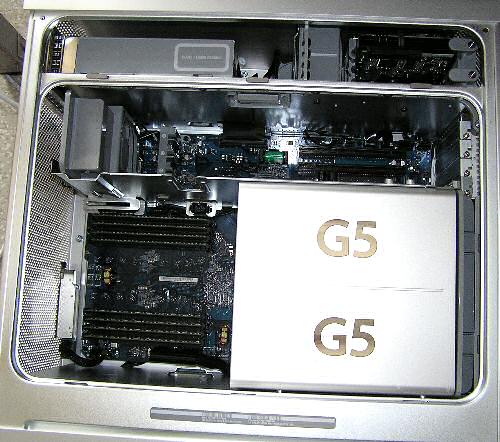Benchmark Configuration
We used the MySQL version (4.0.18) that came with the SUSE SLES9 CD's and Mac OS X Tiger 10.4.1, which was certified to work on our OS. Our YDL Linux reported: "Linux version 2.6.10-1.ydl.1g5-smp (gcc version 3.3.3 (Yellow Dog Linux 3.3.3-16.ydl.7))"Software
Intel, AMDSUSE SLES 9 (SUSE Entreprise Edition), Linux kernel 2.6.5, 64 bit
Workstation tests: Windows XP SP2
Apple PowerMac G5
OS X 10.4.1 Tiger, 64 bit (partially)
Yellow Dog Linux 3.3.3-16.ydl.7
Shared
MySQL 4.0.18, 32 en 64 bit, MyISAM engine
Gcc 3.3.3 and 4.0
Hardware
Here is the list of the different configurations:Apple PowerMac Dual 2.7 GHz, Dual 2.5 GHz
4 GB (8x512 MB) Corsair XMS3200 running at CAS 3-3-3

Intel® Server Board SE7520AF2
4 GB (4x1024 MB) Micron Registered DDR-II PC2-3200R, 400 MHz CAS 3, ECC enabled
NIC: Dual Intel® PRO/1000 Server NIC (Intel® 82546GB controller)
Opteron Server: Dual Opteron 250 (2.4 GHz)
Iwill DK8ES Bios version 1.20
4 GB: 4x1GB MB Reg. Transcend (Hynix 503A) DDR400 - (3-3-3-6)
NIC: Broadcom BCM5721 (PCI-E)
Client Configuration: Dual Opteron 250
MSI K8T Master1-FAR
4x512 MB Infineon PC2700 Registered, ECC enabled
NIC: Broadcom 5705
Shared Components
1 Seagate Cheetah 36 GB (15000 RPM, SCSI Ultra320, 8MB cache)
Maxtor 120 GB DiamondMax Plus 9 (7200 RPM, ATA-100/133, 8MB cache)
Words of thanks
A lot of people gave us assistance with this project, and we like to thank them, of course:Frank Balzer, IBM DB2/SUSE Linux Expert
Jasmin Ul-Haque, Novell Corporate Communications
Matty Bakkeren, Intel Benelux
Trevor E. Lawless, Intel US
Larry.D. Gray, Intel US
Damon Muzny, AMD US
Nick Leman, MySQL expert
Ruben Demuynck, Vtune and OS X expert
David Van Dromme, Iwill Benelux Helpdesk
I also would like to thank Lode De Geyter, Manager of the PIH, for letting us use the infrastructure of the TUK to test the database servers.










47 Comments
View All Comments
JohanAnandtech - Friday, September 2, 2005 - link
Sorry couldn't resist :-). (for the rest of the world, pannekoek is dutch for Pancake)Desktop performance is ok, as desktop apps are similar to the workstation apps we tested in the first article. Those apps spend from 5-20% in the OS, while server apps spend up to 80% of their time in the OS!
However, I should point out that we tested Mac OS X SERVER, so it is a problem for the Xserves.
Pannenkoek - Friday, September 2, 2005 - link
I stand corrected then. However, my reasoning still applies, it's just that Apple relies even more on its brand than on technology to sell server systems apparently. Who runs Mac OS servers anyway, it's an oxymoron. ;-)P.S. Do not mock my nick, it served well in beating godlike UT bots, and should be honoured as much as Loque.
Tanclearas - Thursday, September 1, 2005 - link
"Apple told us that the problem lies in the Apachebench (the client side), which stalls from time to time and thus, generates too low of a load on the (Apache) server."How does this explanation make any sense? Linux obviously doesn't have a problem with these "stalls".
JohanAnandtech - Friday, September 2, 2005 - link
What follows is not what Apple said, but my interpretation...They are probably pointing out that the version for Mac OS X has a Mac OS X specific bug. Of course, who is to blame? I am sceptical like you.
mariush - Thursday, September 1, 2005 - link
Page 4 :We used the following on the Opteron based PCs:
Gcc -O2 -mcpu=G5 flops.c -o flops
And, on the G5 machines, we used:
Gcc -O2 -march=k8 flops.c -o flops
I think it's the other way around.
Houdani - Thursday, September 1, 2005 - link
Aye, was gonna point that out also.In addition, on page 3 should you list the Yellow Dog Linux along with OSX in the Software section for the Apple PowerMac G5?
Shinei - Thursday, September 1, 2005 - link
My question is, would the memory latencies be so high for the 970FX if high-end RAM was used for the Linux tests (like, say, some TCCD or BH-5 at 2-2-2-5), instead of the standard 3-3-3-8 SPD that ships with the G5 system? Or is there some limitation to the G5 motherboard that prevents posting with performance RAM as a way for Apple to ensure that only certain, accepted DIMMs are used with their computers?Anyway, these results are very telling about what the OSX86 Macs are going to perform like--that is to say, ~25% slower than the equivalent Windows/Linux boxes running the same hardware...
IntelUser2000 - Sunday, September 4, 2005 - link
That doesn't matter since they are testing workstations, Irwindale and Opteron is also using CAS3 RAM. No workstations/servers use 2-2-2-5 RAM.
The poor scores of OS X compared to Linux makes sense. G5 was rumored to be fast in speccpu benchmarks but came out to be slower. Must be that rumor systems were benched with Linux and the production was benched with OSX.
I am impressed with OS X's features though.
Jedi2155 - Thursday, September 1, 2005 - link
The G5 motherboard has the limitations due to Apple's way to insure you only buy certified ram. The SPD settings must be perfect.ceefka - Thursday, September 1, 2005 - link
I am humbled by the sheer expertise of Johan. Amazing work, Johan!This makes me even more curious about Intel's contribution to the next generation of Macs. How will they compare to the best G5s?